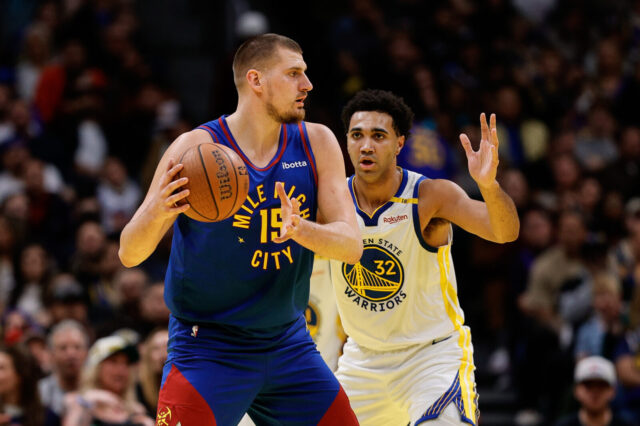Last Thursday and Friday, an annual tradition took place that has quickly grown into a larger event meant to capture the essence of its competitors: the NBA Draft Combine. This was the time for scouts to reconnect with prospects, for front office and coaching staff members to meet potential draftees, and for the players to stand out in any way they can.
Coming away from the event, I was impressed with many of the competitors. Donte DiVincenzo looked like he belonged on the floor after his breathtaking championship game performance last month. Zhaire Smith looked every bit like the athletic wing he probably will be. Others excelled. Some struggled.
But the following five players stood out the most to me:
Mohamed Bamba – Center, Texas
Mo Bamba was a popular name walking into the event, and while everyone knew he wouldn’t be taking part in many of the physical tests, everyone waited with bated breath for his wingspan measurement.
They weren’t disappointed.
Bamba measured in with a 7’10” wingspan, the longest recorded wingspan in combine history. His length is the stuff of legends, and it helped him average 3.7 blocks in 30.2 minutes per game at Texas, the third most in the NCAA this past year.
There’s no guarantee that Bamba becomes the next big rim protector in the NBA. Heck, there’s no guarantee that he doesn’t bust. His shot may never come along, and teams may be able to pull him away from the rim at the next level. Still, his skill set is tantalizing, and he’s clearly a smart dude who knows what he needs to improve to live up to the billing.
As of this moment, I have Mo Bamba over DeAndre Ayton on my draft board.
Kevin Huerter – Wing, Maryland
As someone who focuses far more time on the NBA than the NCAA during the regular season, Kevin Huerter was an unfamiliar player for me, which means he’s likely anonymous for most. Measuring in at 6’7.25” in shoes and weighing 194 pounds, Huerter is the prototypical size for a modern shooting guard with potential to bulk up.
Oh, and he can shoot the rock.
Huerter shot 41.7% from deep this season on 5.5 attempts per game. Some of the shots he attempted were absurdly deep.
Maryland needed his spacing, but it also needed his secondary creation. Huerter averaged 3.5 assists per game, and it showed in 5-on-5 scrimmages this year.
You never want to write off certain aspects of players too early, but I doubt Huerter will ever be an above average defender in the NBA. While he tested well athletically, the tape just wasn’t there in college, and his body doesn’t profile as an impact player defensively (6’7.75” wingspan, suboptimal for wings).
That being said, his impact on the offensive end could make him a riser this year. It’s possible that he could go as high as the middle of the first round, depending on which team wants him.
Melvin Frazier – Wing, Tulane
Melvin Frazier is basically the anti-Kevin Huerter. He wasn’t a great shooter in college, though he did make 38.5% of his long bombs this year. His free throw percentage and previous years of shooting indicate a player who will probably stay in between 30% and 35% in the NBA, depending on his outcome.
Still, the story on Frazier wasn’t about his shooting, but his physical gifts and defensive talents.
At the combine, Frazier measured in at 6’6” in shoes with an absurd 7’1.75” wingspan, a +7.75 mark for length. At nearly 200 pounds with room to bulk up, Frazier projects to be a player who can switch onto all guards and most forwards. He has the quickness, length, and instincts to routinely jump passing lanes. He showcased these skills in the 5-on-5 drills, generating deflections and steals throughout the contest.
Frazier is unlikely to be a major positive offensively. He has some playmaking instincts, but the jumper is still a concern. Still, defensively, he can make a major impact for the right team. Could that team be the Denver Nuggets? Maybe.
The Nuggets need another player who can bind together the defense. Paul Millsap was meant to be that player at power forward, and while he had an impact, Denver’s defense still ranked 26th. This wasn’t entirely due to Nikola Jokic, Jamal Murray, or any individual player. In my opinion, Denver lacked game changers defensively, and they still do.
I’m comfortable saying that Frazier will be a top 20 defender in the NBA in his prime if he develops correctly. It’s nearly impossible to find someone with the instincts he has while also providing the physical tools. Frazier is the rare NBA prospect that should make the impact of a starting caliber player without even factoring in the offensive end. Think of Andre Roberson for Oklahoma City.
If the goal is to improve defensively, he will surely be on Denver’s radar. If Denver passes on him in the draft this year, it will probably be because they found another prospect capable of contributing on defense. It will be a curious draft if that’s not the case.
Josh Okogie – Wing, Georgia Tech
Another relatively unfamiliar name: Josh Okogie impressed many scouts at the combine with his physical tools and an advanced feel during the scrimmages. At 6’4” with a 7’0” wingspan and sitting at 211 pounds, Okogie tied for the best vertical leap at 42” at the sixth heaviest weight. A +8 wingspan should help him play some small forward in bench lineups as well.
His biggest advantage is obviously his physical tools, but his offensive game is surprisingly technical. With some range on his jump shot (38.2% career 3-point shooter) and some burst and ability to contort his body for tough shots at the rim, there’s potential for him to be a better finisher in the NBA than he was in college. Georgia Tech shot 31.2% from behind the arc as a team last year, which left very little space for Okogie, clearly their best player, to operate.
You never want to project too much improvement from a player, but I don’t think Okogie’s efficiency numbers are entirely representative of what he can be. As a shooter, he shows balance when squaring up to the basket on the move. He understands how to get to the rim using shot fakes. He understands how to cut, incredibly important for playing with Nikola Jokic. He also absorbs contact well and finishes through it.
Watch for Josh Okogie Nuggets fans. He won’t be selected at 14, but the Nuggets may consider acquiring a pick in the 25 to 35 range in this draft. Okogie has just enough size to fill some minutes at small forward, and if Will Barton leaves in free agency, that could be necessary.
Lonnie Walker of Miami is consistently dubbed the player most likely to be the Donovan Mitchell of this draft class, but I disagree. The guy who reminds me most of Mitchell is Okogie.
Chandler Hutchison – Forward, Boise State
Much was made of Chandler Hutchison withdrawing from the combine fairly early last week. The rumor goes that a team in the twenties (the Chicago Bulls at 22) made a promise to select Hutchison if he fell to their pick, so he decided not to risk further injury. Take the source for what it is.
There’s a reason why Hutchison has risen though. Much like Kyle Kuzma out of Utah prior to the 2017 draft, Hutchison has been a standout forward in a program not known for producing NBA talent. The Boise State product averaged 20.0 points, 7.7 rebounds, and 3.5 assists in his senior season, and he was one of the only players in the NCAA to lead his team in points, rebounds, assists, and steals.
His skill set is diverse, as he showcased some technical skills in college that he surely impressed some teams with in workouts. His vision improved by necessity with a poor supporting cast. His finishing around the rim and ability to contort his 6’7” frame elevates his ceiling beyond just an off-ball forward.
Ultimately, his value will likely come with his jump shooting and ability to play in dribble hand offs offensively. Defensively, he must use his length and fluidity to stay in front of his man. He didn’t get measured, but I believe his wingspan is over 7’0”, though it’s an unreported number. That’s good enough, if he commits himself, to remain a positive defender throughout his career. He wouldn’t be the elite defender Denver needs, but he would help the cause, and he certainly wouldn’t drag down their offensive efficiency.
Is he good enough for the Nuggets to draft at 14th overall? It’s a stretch, but I believe so. Hutchison’s comfortable creating for himself off the dribble, averaged 4.5 assists per 40 minutes as a 6’7” forward, He has work to do on his outside shot, but the tools are there. If that comes along, I believe he will be a top 10 player from this draft class, and any time a top 10 player could be selected outside the top 10, it’s worth exploring.
The Nuggets definitely shouldn’t consider drafting all of these players. I have a hard time believing Mo Bamba and Nikola Jokic would be successful next to each other. I have a hard time seeing Kevin Huerter playing a significant role on a Nuggets team that has improved their defense significantly.
But the final three guys: Melvin Frazier, Josh Okogie, and Chandler Hutchison, are all underrated players, guys who probably won’t be seen anywhere higher than around 18th in mock drafts. They may not be the best players for Denver to take at 14th overall, but they could be options for the Nuggets if the team decides to move up and down the draft board on June 21st.
With money on the books to clear and quality prospects up and down the draft board, the Nuggets would be wise to take some shots in this draft. Frazier, Okogie, and Hutchison are the tip of the iceberg here. DeAnthony Melton and Troy Brown could be useful guards later in the first round. Jacob Evans and Keita Bates-Diop may provide excellent two-way play on the wing. Dzanan Musa and Isaac Bonga are my two favorite draft-and-stash prospects, each with intriguing skill sets at the forward positions.
Denver missed last year, and they aren’t good enough yet to afford missing twice in a row. Finding a diamond in the rough might drastically improve their ceiling, and in my opinion, there are a lot of diamonds.
They just have to know where to look this rime.
This content is no longer available.


